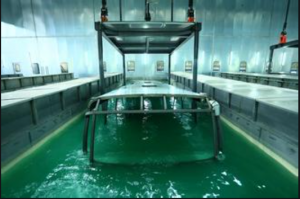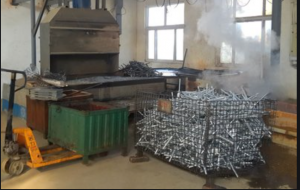In industrial production.Casters, as an important moving part of Its surface treatment technology is essential to enhance the aesthetics, durability and corrosion resistance of the product.Galvanizing as a common surface treatment.Widely used in the surface treatment of caster alloys.This article will detail several common methods of galvanizing casters, the including cyanide galvanizing, zincate galvanizing, chloride galvanizing, and sulfate galvanizing.Designed to provide readers with a comprehensive technical reference.
1、Cyanide galvanization
Cyanide galvanizing, due to its high dispersing power and good plating quality.At one time it occupied an important position in the electroplating industry.However.Due to the highly toxic nature of cyanide itself and the potential threat to the environment.Its use is severely restricted.Nevertheless.development of low-cyanide (microcyanide) galvanizing processes.Making it possible to guarantee the quality of the product while Reduced environmental hazards.Under the cyanide galvanizing process, the The quality of the product is excellent after plating the hardware part of the caster.Especially after color plating has been passivated, the Colors stay vibrant for a long time.
2, zincate galvanized caster welding related terms and concepts
The zincate galvanizing process is an environmentally friendly alternative to cyanide galvanizing.At present, they are mainly divided into “DPE” series of Wuhan Institute of Materials Protection and “DE” series of Guangdian Institute.Both are zincate galvanized with alkaline additives.It has the characteristics of columnar lattice structure of plating, good corrosion resistance, and suitable for color galvanizing.Its typical formulation includes NaOH, ZnO, and specific additives.For example, the combination of “DPE-II” and ethanolamine.This process requires strict control of the composition of the plating solution and process conditions.such as pH, temperature, and current density.to ensure the quality of the plating.After the product leaves the tank, it has to go through a series of post-processing steps.such as washing, polishing, passivating and drying.for optimal results.
3、Chloride galvanization
The chloride galvanizing process is widely used in the caster hardware plating industry.The percentage is upwards of 40%.The passivated (blue-white or silver-white) appearance of the process is comparable to that of chrome plating.and relatively low cost.Typical formulations for chloride galvanizing include KCl, ZnCl_2, H_3BO_3 (buffer), and specific brighteners.The process is particularly suitable for white passivation (blue-white, silver-white).Among them, silver-white passivation due to its stable color.Often preferred as a first choice.However.It is worth noting that Chloride galvanized coatings, when exposed to air for extended periods of time, are The membrane is prone to discoloration.Affects the appearance and corrosion resistance of the product.Therefore.In practice, it is necessary to take appropriate measures to prevent discoloration.
4、Sulfate galvanization
The sulfate galvanizing process, with its low cost and suitability for continuous plating (e.g., wire, strip, etc.).A place in the electroplating industry.Typical formulations for this process include ZnSO_4, H_3BO_3, and specific brighteners.The pH value of sulfate galvanizing is generally controlled between 4.5 and 5.5. By adjusting the composition of the plating solution and process conditions, the A coating with good corrosion resistance and brightness can be obtained.However.Compared to other galvanizing processes, the Sulfate galvanizing may be slightly inferior in terms of gloss and uniformity of the coating.
concluding remarks
In summary.Casters are galvanized in a variety of techniques.Each method has its own unique advantages and scope of application.In practice.Should be based on the specific use environment and performance requirements of the caster.Select the appropriate galvanizing process.Meanwhile.With increasingly stringent environmental regulations and advances in plating technology, the Environmentally friendly, efficient and cost-effective galvanizing process will become the trend of future development.
Post time: Mar-20-2025


